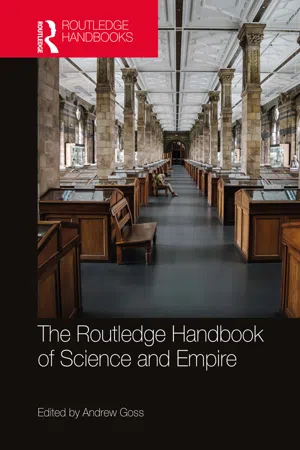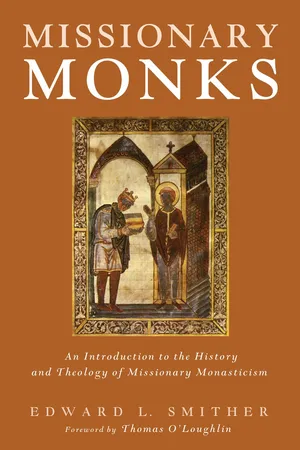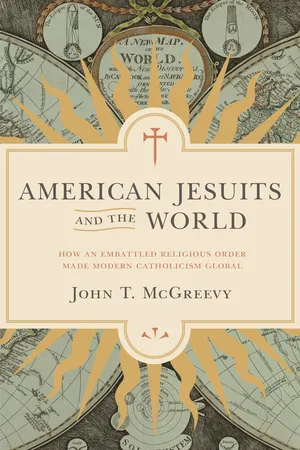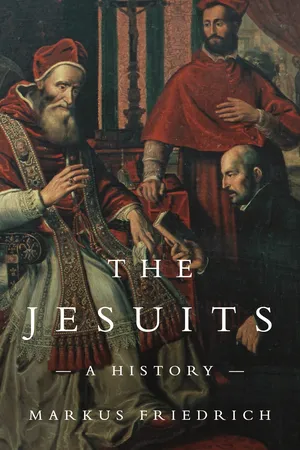History
Jesuit
Jesuits are members of the Society of Jesus, a Roman Catholic religious order founded by Ignatius of Loyola in the 16th century. Known for their missionary work, education, and intellectual pursuits, Jesuits played a significant role in the Counter-Reformation and have been influential in various fields, including education, theology, and social justice.
Written by Perlego with AI-assistance
Related key terms
Related key terms
1 of 4
Related key terms
1 of 3
6 Key excerpts on "Jesuit"
- eBook - ePub
- Andrew Goss(Author)
- 2021(Publication Date)
- Routledge(Publisher)
11Science, empire, and the old Society of Jesus, 1540–1773
Maria Pia Donato and Sabina PavoneSince their foundation in 1540, and well after their first suppression by Pope Clement XIV in 1773, Jesuits have been key actors in the intertwined goals of the competing Catholic empires: colonisation and evangelisation. Both goals implied a momentous effort in collecting, producing, and transmitting knowledge on the natural world, which the Society of Jesus, a missionary order, and shortly after its founding also a teaching order, employed in practically all the regions of the world. As the Jesuits became fixtures throughout the Catholic empires, these attributes came to particularly define the order.The peculiar place of Jesuits in the historiography of early-modern science and empire has been established for more than a century. In the nineteenth and early twentieth centuries, the master historical narrative was about their importance in disseminating science as part of the Western civilising mission. A sub-narrative was often interwoven with this main one, namely the harmonious coexistence of science and religion, and the positive influence of Christianity in world history. The Society of Jesus, which had been restored in 1814 and had progressively resumed its pastoral and educative activities in many European countries and their overseas territories, played a very active part in both debates. As the disciplinary histories of science were being written and shaped, methodologically it meant retracing Jesuit contributions to various branches of science; for this purpose, the fact that one was a Jesuit was to an extent secondary to his being a man of science. - eBook - ePub
Missionary Monks
An Introduction to the History and Theology of Missionary Monasticism
- Edward L. Smither(Author)
- 2016(Publication Date)
- Cascade Books(Publisher)
The Mission was a fictional account of a group of Catholic missionaries striving to evangelize the Guarani, an indigenous people living in the Iguassu Falls region of present day Paraguay. Led by Father Gabriel, the missionaries navigated the jungle and risked their lives to make contact with the Guarani and eventually establish a reduction or mission community among them. However, the greatest opposition that they encountered was with the expanding Spanish and Portuguese empires that were maneuvering to take control of South America. While the missionaries wanted to make Christians of the Guarani, the Portuguese wanted to enslave them. Although fictional, the film succeeds in capturing the difficulties, competing interests, and confusion associated with Christian mission efforts in the age of empire. Further, the film introduces on a popular level the work of the most significant Roman Catholic missionary movement in the world during the sixteenth to eighteenth centuries—the Society of Jesus or the Jesuits.As shown, in the first fifteen centuries the words “mission” or “missions” were not used to describe what is commonly known as mission today. Instead, as Bosch has noted, terms such as “propagation of the faith, preaching of the gospel,” and “apostolic proclamation” among others were use.704 While the Jesuits were innovative cross-cultural evangelists beginning in the sixteenth century, they were also some of the first to call their work “mission.” Luke Clossey notes that while Jesuit missionary work included engaging heretics (Catholic or Protestant) and even ministering to those within the existing church, “by around 1580 Jesuit sources used ‘mission’ to mean a place where one preaches the gospel.”705 As the Jesuit narrative unfolded, these preaching places included Europe, the Americas, and Asia.In this chapter, beginning with a brief survey of the thought and work of Jesuit founder Iñigo or Ignatius of Loyola (1491 –1556 ),706 we will discuss the emergence of the Jesuits as a monastic missionary order. In describing and evaluating early Jesuit mission efforts, our discussion will be limited to the sixteenth and seventeenth centuries and will focus on the work of three innovative Jesuit missionary monks—Francis Xavier (1506 –1552 ) in India and Japan; Matteo Ricci (1552 –1610 ) in China; and Roberto de Nobili (1577 –1656 ) in India.Ignatius of Loyola and the Origin of the JesuitsEthnically Basque, Ignatius of Loyola grew up in northern Spain. At the age of fifteen, he was taken into the Spanish royal court. Though not a professional soldier, he sometimes took part in military campaigns, and in 1521 , during a battle against the French, a cannonball crushed his leg. During the long period of recovery in which he was largely confined to bed, Ignatius passed the time reading. At some point, he was introduced to some Christian devotional literature including Ludolph of Saxony’s Life of Christ and Jacob of Voraigne’s The Golden Legend , a compendium of saints’ lives. While reading these devotional works, Ignatius was ultimately converted to faith in Christ. As he read the saints’ lives, he was particularly moved by the testimonies of Francis of Assisi and Dominic and yearned to emulate their mendicant lifestyle.707 - eBook - ePub
American Jesuits and the World
How an Embattled Religious Order Made Modern Catholicism Global
- John T. McGreevy(Author)
- 2016(Publication Date)
- Princeton University Press(Publisher)
35Still, even the most determined opponents of the Jesuits in the eighteenth century recognized the centrality of the Society to the era’s scientific investigations, theatrical productions, and publishing ventures. What historians term the “Republic of Letters” rested in its Catholic variant on the learned labors of Jesuits scattered from Vienna to Macao.36Nineteenth-century Jesuits sustained some strands of eighteenth-century Jesuit intellectual life, notably a passion for astronomy.37 But the dominant impulse was to again return to the sixteenth and seventeenth centuries, when a philosophical tradition, Scholasticism, derived from Saint Thomas Aquinas, dominated the intellectual life of the Society. One Irish Jesuit serving in the United States scanned the room at a gathering of the world’s Jesuits in 1829 and admitted that “the Society can no longer boast of so many brilliant men as she had in the age when Scholasticism flourished.” He nonetheless insisted that Scholasticism “has always been the Theology of the Society and the weapon with which our forefathers conquered the enemies of the Catholic Truth.”38 At the same meeting, the assembled Jesuits cautioned each other “against the dangers of novelty, especially in any matters that in some way touch on religion.”39Over the course of the nineteenth century this scholastic revival, led by German and Italian Jesuits, triumphed over its intellectual foes through a combination of intellectual firepower and papal patronage. In 1879, Pope Leo XIII mandated primacy of place for Scholastic philosophy in all Catholic seminaries and universities. A generation later, the Jesuit Father General could look back with pride on the central role played by nineteenth-century Jesuits in rescuing Aquinas from the “effrontery” of misguided Catholics unwilling to recognize his enduring wisdom.40 - eBook - ePub
The Jesuits
A History
- Markus Friedrich, John Noël Dillon(Authors)
- 2022(Publication Date)
- Princeton University Press(Publisher)
The pompous, vain scholar was a common, oft-ridiculed caricature of the early modern period. Precisely because this danger seemed so grave, pious Jesuits like Le Valois were plagued by scruples. In conclusion, as much as the institutions and members of the Society of Jesus became preeminent hubs and leaders of the republic of letters and the scientific community of Europe, the Society’s intellectual and scholarly engagement was equally embedded in a Christian framework on both an institutional and an individual level. “Since our way of life and the will of our founder lead us forth into the sunshine and dust rather than permit us to retreat into the shade of letters to write books,” in the words of the college of Li è ge, “it would not be surprising if only a few literary monuments produced by the industriousness of our men had come forth into the light.” 245 The Jesuits did far more than that. The Great Institutions of the Society: A Web of Research Centers The Society of Jesus not only permitted and encouraged scholarly activity but also soon erected a remarkable network of first-rate research institutions. Even in the early modern period, a variety of infrastructure and expensive institutions were needed to conduct efficient scholarly work and research. Hence Jesuit colleges transformed over the decades into veritable research centers. They became centers of European knowledge and scholarship in the early modern period. 246 The colleges performed many different tasks for Jesuit scholars. It all started because the colleges were best suited to guarantee long-term sustenance for the Society’s own “society of scholars.” 247 Only they could provide Jesuit scholars with a regular income. The colleges were moreover the most obvious sites for building the infrastructure of research - eBook - ePub
- Autori Vari, Massimo Carlo Giannini(Authors)
- 2014(Publication Date)
- Viella Libreria Editrice(Publisher)
Esther Jiménez Pablo The Evolution of the Society of Jesusduring the Sixteenth and Seventeenth Centuries:an Order that Favoured the Papacy or the Hispanic Monarchy?In the first decades of the sixteenth century the religious thought of Saint Ignatius of Loyola was forged, giving rise to the Society of Jesus. This period saw some of the richest and most complex moments in ideological tendencies in the Hispanic Kingdoms, particularly in the Kingdom of Castile.84 These were also the years in which the Hispanic monarchy was configured as a political organisation with spiritual power, and the socio-political elites that built it identified themselves with a specific ideological current and spiritual practice. This reality provides the context for the present study.At the end of the fifteenth century and beginning of the sixteenth, Castilian society experienced a radical movement of spiritual renewal, akin to that underway elsewhere in Europe and which led to the Protestant Reformation. In the Hispanic case the movement was complicated by its support by groups made up of Jews who after the 1391 pogroms converted to Christianity and were seeking a radical spirituality based on biblical texts (to match the profound mental transformation they had undergone). This paved the way for the illuminist heresy and, in other instances, intimistic or mystical movements.85 From the social and political point of view this group represented a sort of bourgeoisie dedicated to finance and administration that occupied governing positions in towns and the royal courts. Its members served the fifteenth-century monarchs and collaborated with them in setting up the political organisation of the new kingdoms.86In addition to these religious tendencies there were other currents that sought reform, but based on ascetic principles of a spirituality centred on self-betterment, compliance with norms, and reason. These corresponded to the social sectors that for many generations had been exercising among the infidels a process termed “Re-conquest.” Their values, ideology, and way of life were completely different from the social groups mentioned earlier. And at the end of fifteenth century the Re-conquest completed, these groups were displaced from their position of power by elites of converted Jews. They were the ones who demanded the establishment of the Inquisition (based on the accusation that converted Jews had not sincerely embraced Christianity) and that set up external standards like the limpieza de sangre (cleanliness of blood) to prove authenticity in Christian practices and sincerity in conversion.87 During the reign of Charles V (1517-1555) this Castilian social elite gradually took control of the main government and imperial posts, and its members carried out the configuration of the Hispanic monarchy of Philip II (1555-1598).88 - eBook - ePub
The Colonial History of Paraguay
The Revolt of the Comuneros, 1721-1735
- Adalberto Lopez(Author)
- 2017(Publication Date)
- Routledge(Publisher)
Part 2 The JesuitsPassage contains an image
3 The Jesuit Establishment
In March 1522 the young Spanish nobleman Ignatius Loyola, shaken by deep religious emotions, abandoned his military career for a dream of founding a new religious order. The order of which he dreamt would be militant, ascetic, and dedicated, and its purpose would be to save a Church that was threatened by internal weaknesses and by the spreading heresy of Luther. For years Loyola studied and prayed, until finally, in 1539, the Pope listened to his dream and approved of it. A year later, on September 27, 1540, Pope Paul III signed the bull which officially established the Society of Jesus. Ignatius began his work with ten companions in a small, borrowed house in Rome. By the time of his death in 1556, there were some one thousand Jesuits, some of whom were working in Ireland, Britain, India, Japan, Abyssinia and China.1 In 1549 six Jesuits arrived in Brazil and set out to work among the Indians. Almost two decades later, in 1568, another group arrived in Peru.2The Jesuits went to Paraguay because they were invited to. Despite the presence of Franciscans and Dominicans, who had arrived there in the decades following the founding of Asunción, there was a critical shortage of ecclesiastics in that province. The bishop of Asunción, Fray Alonso Guerra, aware of the good work the Jesuits were doing in Brazil and Peru, asked them to come to his diocese.3 In 1588 the first Jesuits arrived in Asunción and immediately set out to work among the Guaraní Indians in the vicinity of the capital and among the Indians of Guairá. In the years that followed, other members of the order arrived in Paraguay, and by the beginning of the seventeenth century efforts were underway to create in Paraguay a Jesuit province independent of the Jesuit province of Peru. In 1604, the head of the Order in Rome, P. Claudius Aquaviva, decided that Paraguay, Río de la Plata, Tucumán, and Chile were to form an independent province called Paraguay whose capital city was the city of Córdoba.4
Index pages curate the most relevant extracts from our library of academic textbooks. They’ve been created using an in-house natural language model (NLM), each adding context and meaning to key research topics.
Explore more topic indexes
Explore more topic indexes
1 of 6
Explore more topic indexes
1 of 4





